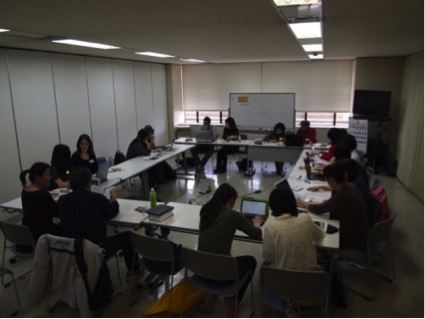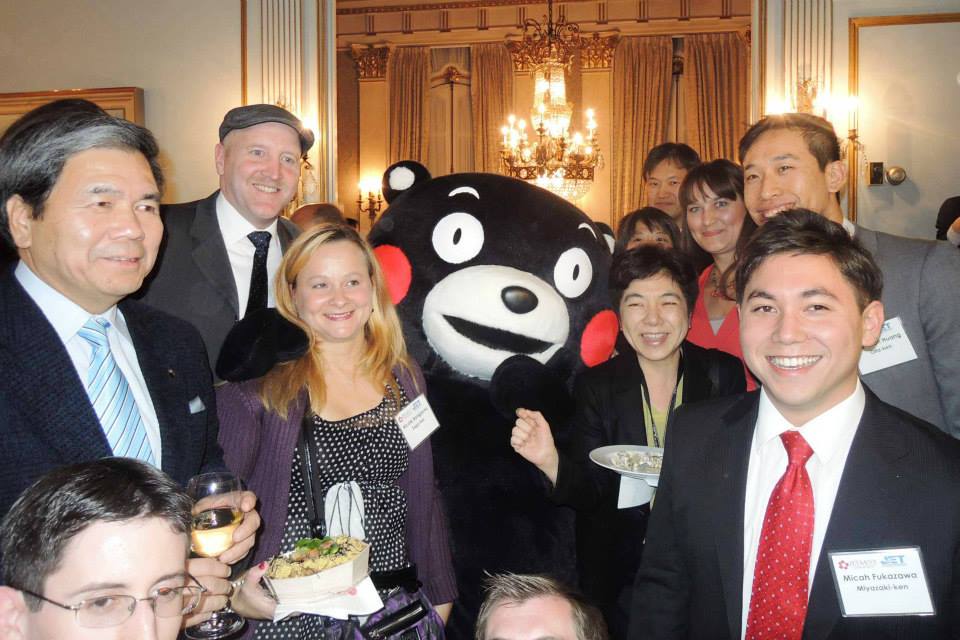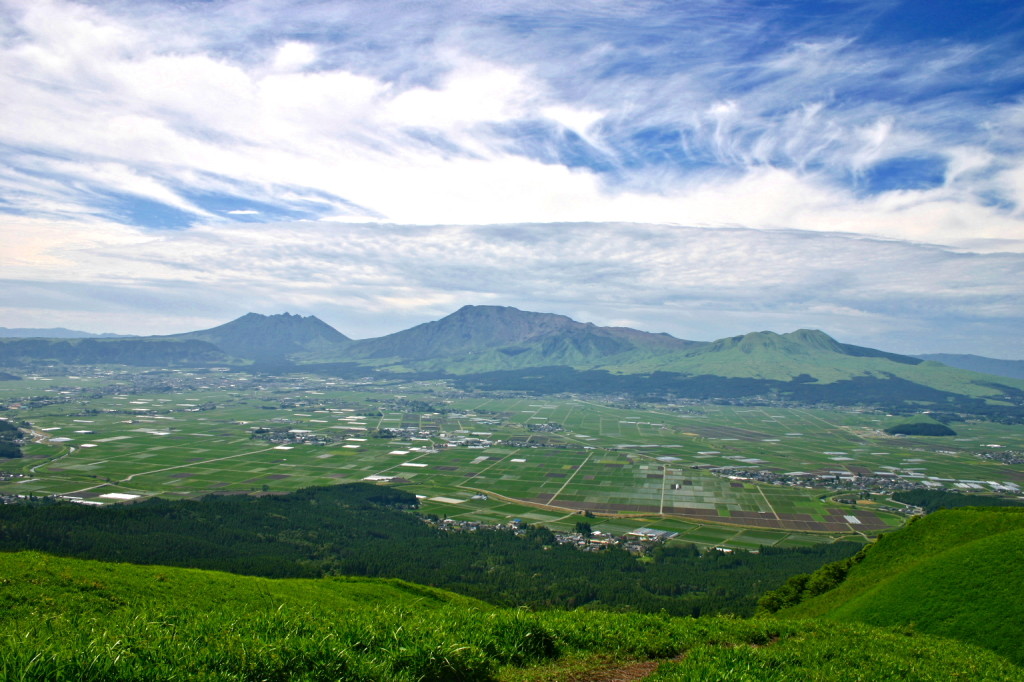Justin’s Japan: ‘Ghost in the Shell,’ Kishi Bashi, Luna Haruna at AnimeNEXT
By JQ magazine editor Justin Tedaldi (CIR Kobe-shi, 2001-02) for Examiner.com. Visit his Japanese culture page here for related stories.
After an unusually chilly spring, it’s finally starting to feel like summer. Enjoy some seasonal events this month that celebrate the best of both fine art and pop art.
This month’s highlights include:
Wednesday, May 28, 10:00 p.m.
The Bowery Electric, 327 Bowery
$5
An all-female quartet that delivers riff-heavy, post-punk anthems, Each of the Hard Nips came to live in New York at different times, from different parts of Japan. And, as conspired by the ever-dexterous hand of fate, they were to cross paths and become fast friends. They quickly formed a cult-like bond whose rituals all included drinking a lot of alcohol and uncontrollably running their mouths. The wine flowed like Kool-Aid and, somehow, they found themselves buying into the delusion that they were capable of forming a kick-ass rock band. Witness the next chapter in their story, with support from Shakes and the Johnnys.
Thursday, May 29, 7:30 p.m.
Ghost in the Shell: Arise – Borders: 1 & 2
AMC Loews Village 7, 66 Third Avenue
$10
In the first two parts of this highly anticipated prequel series of the anime sensation Ghost in the Shell, it’s the year after the fourth World War and cyborg/hacker Motoko Kusanagi finds herself wrapped up in the investigation of a devastating bombing. But she’s not the only one looking for answers—as she delves deeper into the mystery of who is behind the attack, a specialized team unlike any before begins to take shape.
June 6-8
Garden State Convention Center, 50 Atrium Drive, Somerset, NJ
$45-$60
The largest independently organized anime convention in the New York/New Jersey metropolitan area. AnimeNEXT features Japanese creators of anime and manga, voice actors, musical acts, artists, vendors and exhibits, events, panels, workshops, and gaming. This year’s musical guest is Tokyo’s Luna Haruna, who made her major debut in 2012 with the song “Soraha Takaku Kazeha Utau,” the ending theme song for the second season of anime series Fate/Zero. Her latest single, “Snowdrop,” was featured as the ending theme song the second season of Monogatari. Don’t miss her first-ever performance on the East Coast!
For the complete story, click here.
JETs Carry on Taylor’s Legacy in Miyagi
Originally posted on the JETAA USA website:
Donated Books from Ambassador Kennedy Translated into Japanese
Following Ambassador Kennedy’s donation last November of 110 books to the Taylor Anderson Reading Corner at Mangokuura Elementary School in Ishinomaki, the volunteer group that reads to the students there, Soyokaze no Ohanashi (The Gentle Breeze Talks), joined together with the Miyagi International Association (MIA) and current JETs in the prefecture to translate nine of these books into Japanese. The books chosen cover various topics such as the lives of children in the US and other countries around the world, science, and wildlife, and are simple enough to be accessible to younger students.
Ms. Kyoko Sasaki, from Soyokaze, reportedly first reached out to Mr. Andre Perez to ask for his support for the project. Andre, who is currently a Coordinator for International Relations with Miyagi Prefecture and MIA, took on the planning of the event, coordinating details between MIA and Ms. Sasaki. Once these were settled, he reached out to Miyagi JETs through his position as a Prefecture Advisor and tapped into the Miyagi AJET(MAJET) network through Ms. Tanya Zolotareva, another CIR and a MAJET officer. The various groups collaborated, with each taking responsibility for different steps of the process of selecting books, translating them, and affixing the translations. The whole undertaking reportedly went quite smoothly, thanks to MIA’s previous experience with translating books, the eight JETs and roughly 10 other people who volunteered their time and talent, and Mr. Perez’s connections to both MAJET and MIA.
The project was also profiled on Miyagi Prefecture’s Facebook page (https://www.facebook.com/visitmiyagi) and in the Asahi Shimbun and Kahoku Shimbun.
The books will now be available to students at Mangokuura E.S. to look at any time and they will be able to work on their understanding of the English texts by referring to the new Japanese translations. Having prepared translations at hand will also make it easier for the volunteers who read to the children.
As Ms. Sasaki, who is also a friend of the Andersons, having known Taylor, said in talking with one of the local newspapers that reported on the story, “This is a way to express our thanks to Taylor’s family. We want to show them that we are continuing Taylor’s legacy by carrying on her work.”
AJET Professional Development Call with JET alum Anthony Bianchi
On May 7th, we held our fourth AJET Professional Development Conference Call. Our guest speaker was former JET, Mr. Anthony Bianchi (Aichi-ken, Kiyosu City, 1989-91) who now serves as a city council council member in Inuyama City, Aichi prefecture. Mr. Bianchi is often highlighted in the Japanese media and is well-known for being the first American-born elected official in Japan. Click here to read a short interview with him on AJET.net.
Mr. Bianchi discussed the inner workings of his current position, various initiatives to improve English and international communication in his community and how JETs can potentially get involved with local politics in their communities.
Click here to listen to the recording of the call on the AJET website: http://ajet.net/2014/05/13/professional-development-call-anthony-bianchi/
Kyodo News “JET Alumni” Series: Eliot Honda (Ehime)
News agency Kyodo News has recently been publishing monthly articles written by JET alumni who were appointed in rural areas of Japan, as part of promotion for the JET Programme. Below is the English version of the column from April 2014. Posted by Celine Castex (Chiba-ken, 2006-11), currently programme coordinator at CLAIR Tokyo.
***********
Eliot Honda (Ehime-ken, Uwajima-shi, 2009-12) was born and raised in Honolulu, HI, and moved to San Francisco where he received his Bachelor of Fine Arts from the Academy of Art University. After graduation he spent nine years in the TV/Multimedia industry mainly working with clients on commercials, corporate videos, and news. He left San Francisco in 2009 for the JET Programme, and stayed in Ehime for the next three years. He used his multimedia skills to work on sister city relationship programs between Honolulu and Uwajima. After the JET Programme, he returned to Hawaii and joined his mother’s business in real estate, and still do multimedia work on the side.
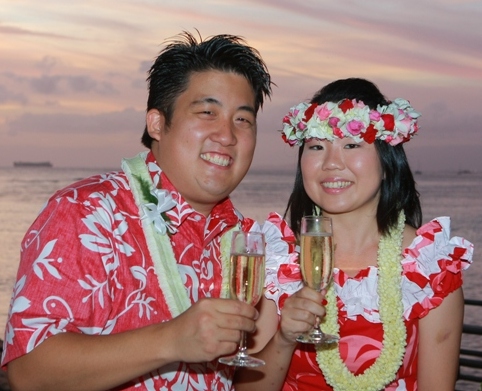
“Without JET I would have never gone to Uwajima and I would have never fallen in love with this city and its people”
Uwajima, my second home
It was the little things that made my time in Japan incredible. Waking up to the smell of the ocean, the sound of my shoes squeaking against the tiled floors of Johoku Junior High School, the taste of fresh fried jakoten and my favorite thing, seeing my students smile.
There’s no single moment that can sum up how incredible my time on the JET Programme was, but my wedding party comes pretty close. Over 200 of our friends and co-workers showed up to celebrate my marriage to a wonderful woman from Uwajima. It was probably the most beautiful thing I had ever seen. It wasn’t just because it was my wedding, it was because in the 3 years I had lived in Uwajima, Ehime I had found a home, a community, and a new love. I fell in love with a city that I had never been to, and I had fallen in love with the people of Uwajima.
This is a small city whose money doesn’t come from tourism, and doesn’t have the flash and awe of Tokyo, but it has heart like I’ve never seen in all my life. From mountain to ocean you can find beauty all around you, and the warmest people I have ever met. I had several encounters with elderly men and women who I had asked for assistance and soon found myself engaged in a twenty-minute conversation. The words “I’m from Hawaii” spawned a whole new conversation. There were moments in which I had to recall what it was I was looking for simply because we had been talking for so long.
There were moments when I would have to take a breath and ask myself: “Is this really happening? Am I really here?” Every day in Uwajima, whether a good day or a bad day, was a gift. Not only to be in Japan, but just to be a part of the growth of the students, and the community. There were three Hawaii ALTs in Uwajima and all of us acted as that bridge between Hawaii and Uwajima and were more than happy to share our culture with the students. I think my favorite time with my students was the free-time between classes and during sports activities. They would ask me many questions about Hawaii and America, and they’d share their culture with me. It always warmed my heart to see their eyes light up when I’d talk about my hometown. I tried to give these students as much of myself as I could, but they gave me so much more. Read More
Kyodo News “JET Alumni” Series: Dominic Abordo (Akita)
News agency Kyodo News has recently been publishing monthly articles written by JET alumni who were appointed in rural areas of Japan, as part of promotion for the JET Programme. Below is the English version of the column from February 2014. Posted by Celine Castex (Chiba-ken, 2006-11), currently programme coordinator at CLAIR Tokyo.
********
Originally from San Francisco, CA, Dominic Abordo (Akita-ken, Kosaka-machi, 2008-11) holds a Bachelors Degree in English Literature with a minor in East Asian Languages from Berkeley University. He spent three years working as a Coordinator for International Relations (CIR) in rural Akita before enrolling in a Master’s degree in Social Work from Columbia University, NY. He currently works as a Freelance Consultant in Social Work in New York.
A “Big City Boy” in Snow Country
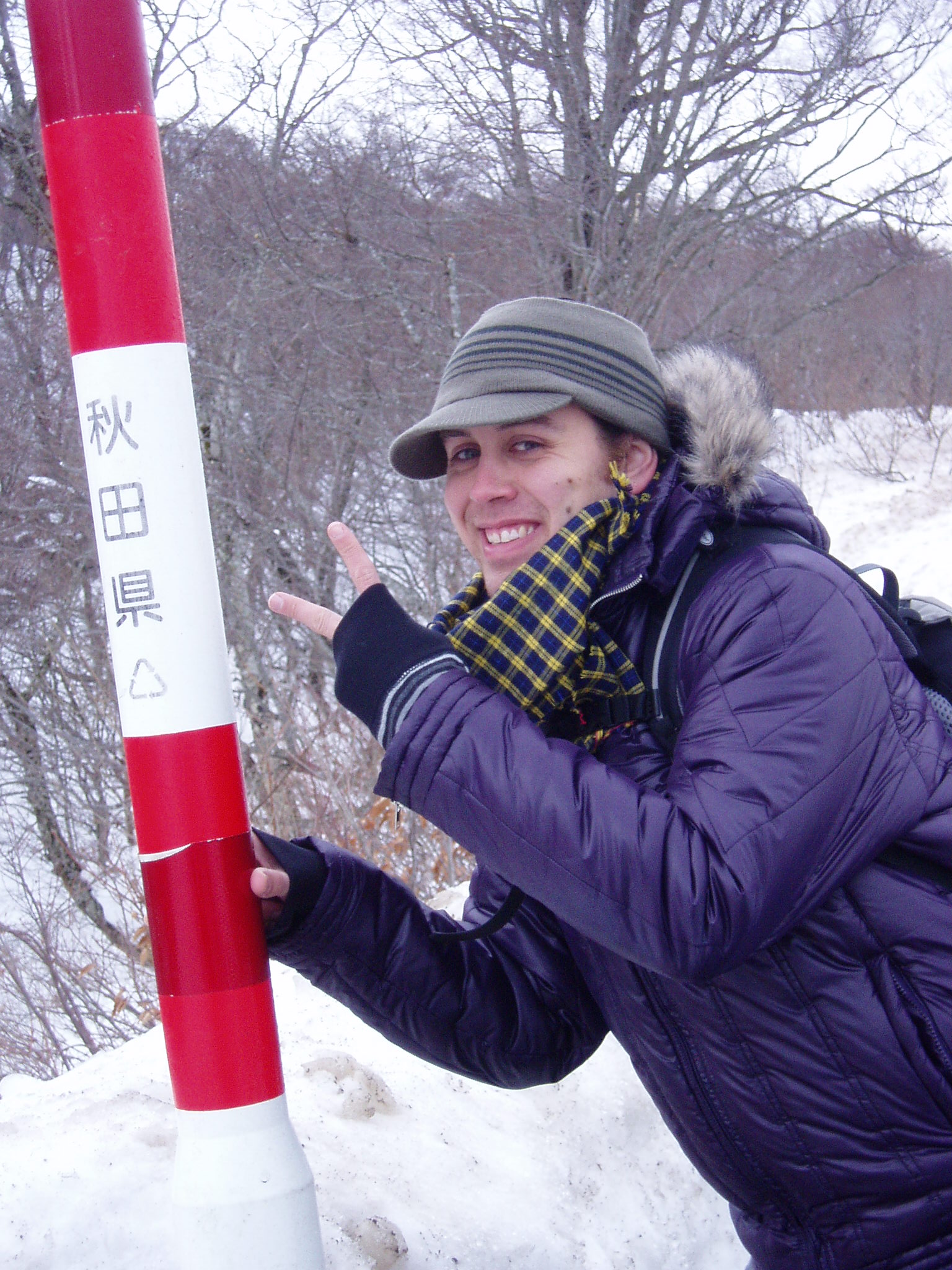
“The one thing that I will continue to share with my friends and family is that the people of the small town of Kosaka-machi have some of the biggest hearts in the world.”
Akita (əˈkiːtə), noun: 1. one of the northernmost prefectures on the Japanese island of Honshu; 2. the prefecture that I, Dominic Abordo, called “home” for three years.
If you ask the average American about Japan, it is highly unlikely that Akita Prefecture – a gem of the Tohoku Region famous for heavy snowfall, rice, kiritanpo, and sinister mountain demons called namahage – will be included in his or her response. Despite living in Japan for three years prior to the JET Programme, I, too, knew very little about my future home. Thus, I was admittedly nervous when I first arrived in Kosaka-machi, a small town of approximately 6,500 people located in the northeastern corner of Akita. I assumed that my time as a Coordinator for International Relations (CIR) would be full of new adventures, challenges, and opportunities, but I had no idea that the experience would have such a positive and lasting impact on my future.
Although it took almost one year to master the local dialect, Kosaka-machi soon became a second home to me. The natives were eager to introduce me to the natural beauty and hidden treasures of their hometown, including landmarks such as Nanataki Waterfall, Lake Towada, and the Korakukan kabuki theater. They often accompanied me to the best restaurants, bars, and izakaya in the area, sharing personal stories about their families, jobs, and travel experiences over a meal or a few drinks. Elementary school students and adults alike offered warm greetings when we ran into each other around town. Perhaps most importantly, they did everything they could to make sure that I was happy, healthy, and an active part of the community. Little did I know that my love for dance, music, and performing arts would enable me to form lasting connections with so many of them. Read More
Japan Times features JET alum Matthew Cook and his work with Osaka’s English Reformation Project Team
****************************
Very nice article on JET alum and former AJET Chair Matthew Cook (Osaka-fu, 2007-12) about his path from JET to becoming an agent of change for the Japanese English education system through is unique role with Osaka Prefecture’s Board of Education. Matt is also the founder of the Kansai JET Alumni group. FYI, you can also click here for a recent JQ profile of Matthew Cook by JETAA New South Wales‘ Eden Law (Fukushima-ken, 2010-11) .
Changing the system starts by challenging it
BY TERU CLAVEL
Just seven years after first participating in the JET program in Osaka, Matthew Cook from Danville, Virginia, is making great strides as a pioneer of English-language education reform in Japan. Having never previously been to an Asian country, Cook is now one of seven members of Osaka’s groundbreaking English Reformation Project Team, having been appointed by Osaka superintendent Toru Nakahara in 2013. With an unswerving commitment to English-language education and a little luck, Cook’s efforts may pave the path for Japan’s next generation of global leaders.
Cook applied to the JET (Japan Exchange and Teaching) program because it was “the most lucrative, stable and safe way to get to Japan.” Having run his own karate dojo in the United States, he felt the need to gain a deeper understanding of the Japanese culture behind it. However, Cook was waitlisted and needed to make a snap decision when he was offered a position within a month of the JET start date. “I had totally assumed that I wasn’t going to get in,” he says.
Cook’s initial placement was less than ideal, though. He was forewarned that the Osaka junior high school to which he was assigned might be challenging, but he was not prepared for the “few students who were stopping class altogether, violence in the classroom or kids getting up and leaving.” Read More
New Saga JET website!
Here it is! http://sagajet.com
(Sorry, kind of a bare bones post I know.)
Kyodo News “JET Alumni” Series: Laura Tasharofi (Kochi)
News agency Kyodo News has recently been publishing monthly articles written by JET alumni who were appointed in rural areas of Japan, as part of promotion for the JET Programme. Below is the English version of the column from January 2014. Posted by Celine Castex (Chiba-ken, 2006-11), currently programme coordinator at CLAIR Tokyo.
*********
Laura Tasharofi (Kochi-ken, Yusuhara-cho, 2004-07) hails from Gold Coast, Queensland, Australia. After a Bachelors Degree in Japanese Studies from Griffith University, Gold Coast, she joined the JET Programme and was placed as a CIR in a little Shikoku town where she spent the next three years. She currently works as the Student Loan Coordinator for Queensland TAFE and has been the President of JETAA Queensland since 2011.

“I always encourage young people I meet to consider the JET Programme as a life experience, and I am eternally grateful for the opportunities the JET Programme gave me.”
The Town Above the Clouds
Yusuhara: Town Above The Clouds (梼原町:雲の上の町). With a slogan like that, I suppose it should have been obvious, but as my supervisor drove me home from Kochi Ryoma Airport, I couldn’t believe how far we were climbing into the mountains. The deep green pine trees were towering over the winding road, and there were wisps of low cloud around us after the rain on that hot, humid day. The scenery was beautiful. Little did I know, I would spend the next three years becoming part of a wonderful community and making life-long friends.
Yusuhara had a population of a little over 4,000 people at that time. It is famous for being on the route that Sakamoto Ryoma took when he made his crusade to bring about the Meiji Restoration. You can follow the signs and walk the ‘Sakamoto Ryoma escape route’ (坂本竜馬 脱藩の道), through the hills to finish in Ehime-ken. It has a beautiful onsen and hotel, a pretty river and it is a short drive to the Tengu Highlands. Such a picturesque place, but there weren’t many tourists in those days. Some time after I left, NHK ran a TV series about the life of Sakamoto Ryoma, and that put Yusuhara on the map as a tourist destination for fans of the show.
In a small town like that, a tall Australian woman like me really stood out. People quickly came to recognise me. Everyone would say ‘good morning’, or ‘hello’ as I travelled to work or walked around town on the weekends. They knew where I lived and which car I drove. I very quickly learned that everyone knew where I was and what I was doing at any given time. At first I felt like I had lost my privacy, but I soon felt very safe and comfortable living in a small, friendly community where everyone knows each other.
I was quite busy as a CIR. I spent a lot of time visiting schools to do cultural and English lessons with kids from kindergarten up to Junior High School. I taught the kids how to play cricket, how to make rocky road (chocolate filled with marshmallows, nuts and cherries), I arranged a letter and Christmas card exchange between some of the students in Yusuhara and students at the school where my mum works in Tasmania. I assisted with the annual overseas study trip for 10 students from our town to our sister school in Queensland. I helped out at town events like the marathon and the kagura taikai (神楽大会). Read More
Kyodo News “JET Alumni” series: Jenson Deokiesingh (Toyama)
News agency Kyodo News has recently been publishing monthly articles written by JET alumni who were appointed in rural areas of Japan, as part of promotion for the JET Programme. Below is the English version of the column from December 2013. Posted by Celine Castex (Chiba-ken, 2006-11), currently programme coordinator at CLAIR Tokyo.
*********
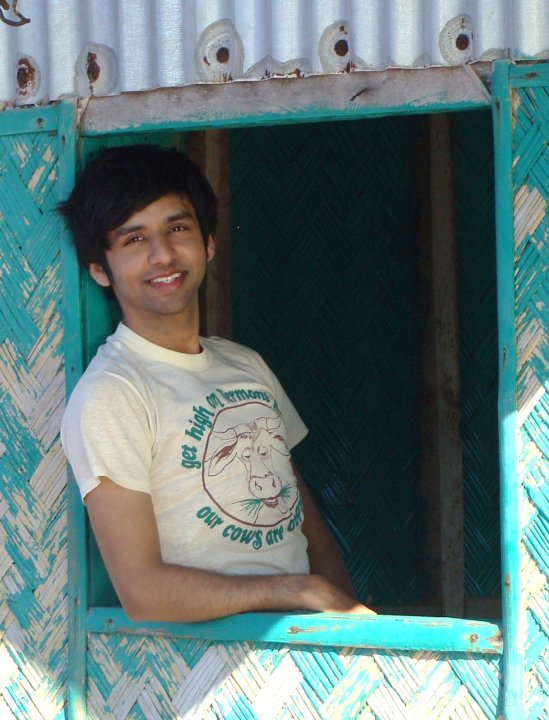
I am reminded that my love story was very much a mutual one and I fondly think, “In life we meet, only to part, so we can meet again.”
Untitled
I have always loved Yayoi Kusama. There’s an unexplainable magic and unorthodox beauty about her signature polka dot patterns. I had seen compelling images of her kaleidoscopic, “Love is Calling,” installation designed specifically for the Mori Art Museum’s 10th Anniversary Exhibition and immediately knew I had to see it.
On September 1st, my last day in Japan and ironically the last day of the “All You Need Is Love” exhibition, I went searching for Kusama to bid her a final farewell.
As I meandered from one provocative exhibit to another, I found myself riveted to the entrance of the section, “Losing Love”. Written on the stark white wall, in simple black text, were the words: Great love stories are often about the encounter with and subsequent loss of loved ones. I stood there, in a trance, repeating these words, over and over, until they became deeply etched in my memory.
A film of tear glazed my dark brown eyes; wedged in my throat was a painful lump; and my heart slowly crumbled with each excruciating beat it gave. The inevitable truth I was desperately trying to avoid was now blinding me in a sobering reality. My life as a JET, my Japanese love story, was irrefutably over.
On Friday, October 18th, I had my first job interview since returning to my vibrant and colourful country of Trinidad and Tobago. Truthfully, the interview was going terribly. A frightening combination of nerves and adrenaline had left me uncharacteristically inarticulate. I was about to cite it as one for the history books, when the interviewer inquisitively said, “Please tell me about your experience on the JET Programme.”
That one sentence was all I needed to give me the confidence I had momentarily lost. With an inescapable smile imprinted on my face, I gleefully declared that living and working in Japan have been incontrovertibly the best experience of my life thus far. And, it truly was.
My first years in Toyama are as vivid and clear as Toyama’s spring mountain waters. The hot embarrassment pulsating through my body as I wished the staff after a long day’s work “Gochisousama deshita (Thank you for the feast)” instead of the customary “Otsukaresama deshita (Thank you for your hard work)” still turns my brown cheeks rouge. Excitedly waking up early in the morning for my first school photo, wearing my best suit, whistling as I biked to work, and then having a crow defecate on my new suit still brings me uncontrollable laughter. Taking a lunch break at the school’s garden, reading Haruki Murakami’s “Sputnik Sweetheart” and then being stung by a several caterpillars still gives me chills. However, crazily running into the staff room, shouting, “Itai! Abunai! Itai! (Pain! Dangerous! Pain!)”, and having my vice principal heroically take the school’s vacuum to vacuum my back change those shudders into immeasurable smiles. Read More
Let’s Talk Japan, Episode 18 – Aikido
Let’s Talk Japan is a monthly, interview format podcast covering a wide range of Japan-related topics. Host Nick Harling (Mie-ken, 2001-03) lived in Japan from 2001 until 2005, including two great years as a JET Program participant in Mie-Ken. He practices law in Washington, D.C., and lives with his wife who patiently listens to him talk about Japan . . . a lot.
In this episode, I speak with Michael Veltri, the owner and chief instructor at DC Aikido in Washington, DC. Together we discuss the history, philosophy and benefits of Aikido.
Enjoy!
Nick
If you have not already done so, be sure to “Like” the podcast on Facebook, and follow the podcast on Twitter @letstalkjapan. Additionally, please consider leaving a positive rating and/or review in iTunes.
Kyodo News “Rural JET alumni” series: Elizabeth Gordon (Iwate)
News agency Kyodo News has recently been publishing monthly articles written by JET alumni who were appointed in rural areas of Japan, as part of promotion for the JET Programme. Below is the English version of the column from November 2013. Posted by Celine Castex (Chiba-ken, 2006-11), currently programme coordinator at CLAIR Tokyo.
*********
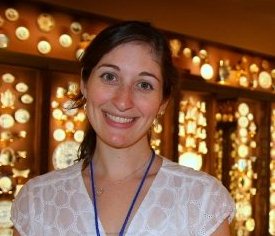
“I discovered through these exchanges that the people with whom I was talking wanted to know as much about me, about Chicago and about America as I wanted to know about them, Iwate and Japan. Through these interactions over the course of two years I began to gain a small understanding of the subtle nuances that were part of the culture in which I was living.”
Originally from Chicago, Elizabeth Gordon (Iwate-ken, Ninohe-shi, 2003-05) holds a Bachelors Degree in Psychology with a minor in Japanese Studies from Northwestern University, IL, and a Master’s degree in East Asian Studies from Columbia University, NY. She spent two years teaching English in rural Iwate before joining the Japan Foundation in New York as a Program Officer. She currently works as the Director of Private Events of the Adler Planetarium in Chicago.
Soba Diplomacy
Noodle making is an art, not to be taken lightly. Only a true master can produce the perfect noodle. After the wooden board is cleaned, the ingredients are kneaded in perfect rhythm until the correct consistency is achieved, and only the master knows for sure when that is. The rolling pin goes back and forth in a circular motion but forms a perfect rectangle, which is folded in half, then in half again, and in half again. Ever so delicately, the master cuts, slice after slice, all exactly the same width. They are cooked for just the right amount of time and then served with a simple dipping sauce sprinkled with scallions. The movements were ingrained in his muscles. I imagine he could have completed the whole process with his eyes closed. There is simplicity in the process, but the flavor is layered and complex.
When I arrived in Ninohe City, Iwate Prefecture in the summer of 2003 as a participant on the JET Program, I did not know a soul, nor had I ever heard of Iwate Prefecture. There was a short orientation in Tokyo, followed by a shorter orientation in Iwate’s capital city of Morioka. It was on the final day of orientation in Morioka that I met my supervisor, Mr. Sato. He picked me up and we drove the one and a half hours through the countryside back to Ninohe City. Mr. Sato did not speak much English and his heavy Iwate dialect was difficult for me to understand. We did, however, find common ground in a little bit of sports but mostly through food. I listed all of my favorite Japanese dishes, and he loved the fact that I could eat with chopsticks. He brought me to the Board of Education office and showed me my desk, which would be my home base for the next two years.
There was no rest for the weary, however. Before I could sit down I was whisked away on a driving tour of the entire city. We stopped at my two junior high schools and one of the eight elementary schools at which I would be teaching. I was asked to give a short self-introduction at each location. We also stopped at city hall to meet the mayor, and at the bank to open an account. Back at the board of education it was suggested that I be taken to the grocery store before I was dropped off at home for the evening. Read More
Kyodo News “Rural JET alumni” series: Nic Klar (Niigata)
News agency Kyodo News has recently been publishing monthly articles written by JET alumni who were appointed in rural areas of Japan, as part of promotion for the JET Programme. Below is the English version of the column from October 2013. Posted by Celine Castex (Chiba-ken, 2006-11), currently programme coordinator at CLAIR Tokyo.
********
Originally from Australia, Nicholas Klar (Niigata-ken, Itoigawa-shi, 1995-97) wrote the book “My Mother is a Tractor” about his life as an ALT in Omi, Itoigawa, Niigata-ken. After JET he worked for many years as a college counsellor and History teacher in international schools before returning to Japan to live. He now runs a small business in the Japan Alps, “Explore the Heart of Japan” as well as a popular travel website (http://myoko-nagano.com).
Remember that here all is enchantment, – that you have fallen under the spell of the dead, – that the lights and the colours and the voices must fade away at last into emptiness and silence. –Lafcadio Hearn
It was a stark winter’s day as usual in Niigata-ken, grey like sodden blanket. Not one that I had set out on seeking ghosts, but it suited the mood. As I changed trains in Naoetsu for Ōmi the old tempura stand I had been hoping for a snack at was still there, but today it was closed. It seems even the sturdy yukiguni could not stand the sort of weather that was being hurled at them this winter from across the Japan Sea. I settled into my seat, its soft orange covers familiar like an old friend, and waited for the delayed departure. I scrubbed the mist from the brown streaked windows with my hand as the motor idled and the minutes slipped by. Outside schoolboys in their traditional Prussian kit seem oblivious to the biting gusts of artic-like snow. Eventually with the sound of the station attendants whistle the doors snapped shut and the blue and white carriage groaned away from the platform.
As we crossed over the dark frigid waters of the Himegawa almost an hour later I grew excited. I hadn’t been back to the haunts of my old town for years. It was an unplanned visit and no-one really knew I was coming. I looked over for the local chugakko as the train passed by, obscured now by the construction of the new Hokuriku shinkansen. Framed behind those were the mountains I had loved so much. So many times I had taken my bike up into those North Alps making new discoveries, getting lost in the awesome beauty of its nature. Days of sunshine, days of rain. How I missed them. And the ghosts that inhabited them.
To the right there was a slight glimpse of my former apartment block. Not mine anymore, not for many years. In fact I think it now lays empty, apart from maybe a ghost or two, as the town depopulates. Tall, grey, forbidding – once referred to by a friend as, “…classic 1950’s communist Romanian style architecture”. The memory of that remark brought a brief smile to my face. Yet, it is the only place I will ever live in that has a sea view at the front and the mountains at the back. Grand views of God’s great vista on tap.
When the doors clunked open at Ōmi eki it was if nothing had changed. The chimes rang the same they had all those years ago and the black asphalt platform lay several centimetres thick with windswept snow. It felt soft under my feet as I began my ascent up the cold cement stairs. Standing in his post was my first metaphorical ghost – Watanabe-san the station master in the same blue-clad uniform, looking not a whit older than when we had last met a few years ago. He didn’t recognise me of course, even though I had taught his daughter at Ōmi chugakko. During my stay many of the station attendants had greeted me by name each time I passed through the gate. The inside of the station was a time capsule still painted the same green, apart from a more modern poster here and there, populated by even more ghosts of my memories. Local oba-chan in the waiting room still sat chatting on wooden bench seats around the kerosene heater behind glass doors. The three old shuttered-up ticket windows still existed – a sad reminder from the more grandiose boom days of Ōmi. Perhaps they were stubbornly retained in the forlorn hope that those times may yet return once again. Read More
“Brain Man” – Film Review from Australia’s Japanese Film Festival
Australia’s 17th Japanese Film Festival is soon embarking on its last city tour in Melbourne, the capital of the southern state of Victoria, after being shown around Australia in the first ever national film festival administered by the Japan Foundation. Eden Law (Fukushima-ken ALT 2010-2011, current JETAA NSW committee member) got to see some of what’s on offer during its recent run in Sydney. This one’s for you, Melbournites! Don’t say we don’t do anything for you south of the border.
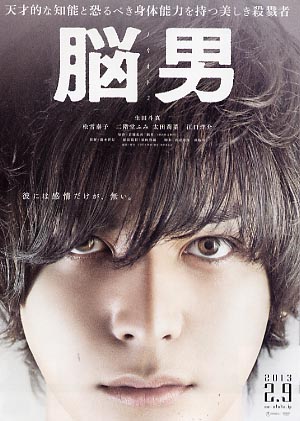
Doumo arigatou Mr Roboto
At times graphically brutal and sadistic, “Brain Man” moves at a brisk pace, frequently keeping the audience off-balance with unsettling scenes and stylistic ideas that are reminiscent of other films in the genre. An adaptation of the novel “No Otoko” by Urio Shudo, the novel itself won the 2000 Edogawa Rampo Award for newcomers to crime fiction. In it, a series of sadistic murders and explosions pressures the police lead by Detective Chaya (Yosuke Eguchi, who must be channelling every crusty, grouchy detective character ever to exist in film) to find the culprits responsible, and soon enough Ichiro (Toma Ikuta) is apprehended as the prime suspect. However, things are rather decidedly odd about Ichiro, who is more like a robot than a human, going like clockwork to… go, unable to feel pain or emotion. Although in peak physical condition (via an establishing shot as the camera lingers over Toma’s skinny yet hard-bodied torso, which is itself inhumanly bereft of fat), he is clearly a special psychiatric case, which is where Dr Washiya (Yasuko Matsuyuki), a brilliant psychiatrist, comes in to help with police investigation. Although like other characters in the film, she herself carries a trauma, that fuels her determination to investigate and uncover the truth about Ichiro, and ultimately the case.
This film calls for a certain suspension of disbelief – probably more than usual, with the number of implausibilities it has. This is not a film that is completely grounded in reality, even given the premise of a serial-bomber-Saw-wannabe and a man-bot. However, that’s not to say it’s done badly. Director Tomoyuki Takimoto excels at creating a tense, unsettling atmosphere, typically using lots of dark cold colours that’s grim and claustrophobic, even in the day scenes. There are unexpected shocks punctuating the film at a brisk pace, creating a sense of dangerous unpredictability for the characters. Takimoto doesn’t shy away from being graphic either, what with body parts being ripped, stabbed, shredded or sliced merrily in some form or another, in sadistically creative ways. Some of the characters and baddies are suitably over the top (especially Fumi Nikaido and Rina Ohta as Noriko and Yuria, in deliciously scenery-chewing performances), though are a little obscure in their motivation. But whatever man, they’re totes cray-cray – who can understand why they do the things they do.
But that sort of unreality element can work against it, especially when the film, in the form of Dr Washiya, seems to be exploring more serious and unexpectedly philosophical issues: can a person be rehabilitated, or their basic nature changed? In the beginning of the film, Dr Washiya advocates a new form of “narrative” therapy to habilitate hardened criminals, contrary to the accepted methods of the establishment. It’s a theme that surfaces once in a while throughout the film, although largely overwhelmed by the more exciting and visceral violence and terror. But during those moments, Matsuyuki (as the doctor) does really well in giving her character the right mix of toughness and vulnerability, and her interaction with a “cured” patient, brings a totally different kind of disturbing creepiness thanks in no small part to Shota Sometani who plays Shimura, the patient in question. But these differences seem out of place in a film that’s usually more thrills and spills, in a world where a grizzled no-nonsense detective has long hair and the living coin-operated boy somehow has access to a great hair stylist and chic clothes.
However, as mentioned, “Brain Man” is still done well and is highly enjoyable to watch, especially if you’re a fan of the thriller/crime/mystery genre. As Ichiro, Toma Ikuta’s highly restrained acting, communicating only through subtle body language and stares, is quite absorbing. And “Brain Man” manages to deliver right to the end, as a final emotional shock is revealed.
PS: Bonus points for the ending credit song: “21st Century Schizoid Man” by King Crimson!
Brain Man (No Otoko) by Tomoyuki Takimoto, released in Japan February 9 2013, starring Toma Ikuta, Yasuko Matsuyuki, Yosuke Iguchi, Fumi Nikaido and Rina Ohta.
JQ Magazine: 2013 JETAA Oceania National Conference Spotlights Sister City Relationships
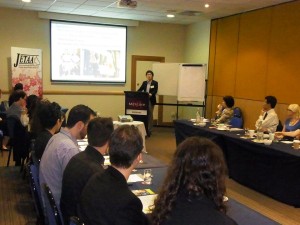
Hiromi Hakuta, assistant director of CLAIR Sydney, addresses alumni at the JETAA Oceania National Conference, Brisbane, Nov. 2013. (Courtesy of Hiromi Hakuta)
By Eden Law (Fukushima-ken, 2010-11). After the JET Programme more than fulfilled its promise of “an experience of a lifetime,” Eden returned to Sydney, Australia, where he joined the JETAA New South Wales chapter to take advantage of the network and connections available to undertake projects such as an uchiwa design competition for the Sydney Japan Festival. He also maintains the JETAANSW website and social media. Other than that, he’s a web designer and a poet, gentlemen and raconteur.
One of the best things about being a member of JETAA is the community, and over the weekend of 15-17 of November, the Oceania community of JETAA got together for our annual antipodean regional conference. For those of you up north who don’t know, JETAA Oceania comprises of five Australian chapters (the state chapters of Queensland, New South Wales, Canberra, the uber-chapter of South Australia-Victoria-Tasmania, Western Australia) and three New Zealand chapters (South Island, Auckland and Wellington). Representatives from Sydney’s CLAIR office (Tsuyoshi Ito, Hiromi Hakuta and Julien Ansart) attended as observers of the proceedings. This year, JETAA Queensland played host in Brisbane, the northern capital that looks to Asia and is close to the Gold Coast, a favoured destination for young Japanese looking for sun, surf and sand. Appropriately, we had our first lunch meet on Friday at MOS Burger, the famous Japanese fast food chain whose only non-Asian presence internationally is right in Brisbane.
JETAA Oceania was invited to attend the Welcome Back Reception for returning JETs at the Japanese Consul General’s home in Brisbane on the Friday night, a chance of course for us to network and hobnob with the cream of Brisbane’s Japanese cultural community. And after the reception finished (early, predictably), JETAA kicked on in town for a night out (hint: it’ll always involve karaoke—usually lots of obscure Japanese songs sung by that one quiet serious person who turns into a blurry, hip-thrusting maniac).
The first day of the conference began on Saturday, early (for some, too early) at our hotel and Laura Tasharofi, president of JETAA Qld, began proceedings by explaining the theme of this year: Australia-Japan sister-city relationships. As explained by Hakuta-san, of all countries, Japan has the most links in Oceania, with 108 sister city relationships in Australia and 44 in New Zealand. Therefore, the potential for JETAA to get involved is great, and the conference’s objective is to find ways to participate and be more prominent in our local communities. To start discussions and provide ideas and examples, two guest speakers, Ross Humphreys and Barry Hancock, were invited who are respected members of the Brisbane community and its influential sister city relationships.
By Mark Frey (Kumamoto, 2002-2006), mark.frey@jetaanc.org
Updated with media coverage of the visit.
Boston and New York had the honor of hosting Kumamon’s North American debut last week! Who is Kumamon you may ask? The rosy-cheeked, sack-shaped bear is the official mascot of Kumamoto Prefecture in Kyushu. Voted the top “Yuru-kyara” (cuddly mascot character) in Japan, he has taken Japan by storm and sold more than $300 million worth of merchandise in 2012 alone.
Kumamon’s remarkable success in promoting his rural prefecture across Japan–there is even an exclusive “Kumamon Goods” store in Tokyo’s upscale Ginza neighborhood–is being studied in government offices and marketing departments across Japan. In fact, no less than the Wall Street Journal has published no fewer than three articles about the phenomenon.
If you’d like to learn more about Kumamon, including what he does every day, I recommend checking him out online:
Facebook page: https://www.facebook.com/kumamotodiary.en
Home page: http://kumamon-official.jp/
Kumamon accompanied Kumamoto Governor Kabashima during his visit to Boston on Novermber 12-13, which included giving a lecture at Harvard on “The Political Economy of Kumamon: A New Frontier in Japan’s Public Administration.”
Kumamon spent time with the Boston Red Sox’s mascot, Wally the Green Monster, for what was surely an important, high-level diplomatic meeting. The full itinerary of their Boston visit can be found here, here, and here. Media coverage of their visit includes:
The lovable bear and Governor Kabashima made their way down to New York on November 14, where they paid back the compliment with a visit the Wall Street Journal. Later they visited the Consul General’s residence, as part of a special reception to promote Kyushu. JET alumni from the New York Chapter of JETAA representing all of the prefectures of Kyushu were invited to the reception. In addition to presentations on Kyushu travel, tourism and shochu, Governor Kabashima introduced Kumamon. Guests dined on Kumamoto oysters and “ekiben” prepared by the chef from Hataka Tonton, and sipped shochu from the region. Kumamon and Governor Kabashima’s full New York itinerary can be found here. Media coverage of their visit includes:
Photos of JET alumni at Kyushu Promotion event at Consul General’s residence
Governor Kabashima is an interesting person. He was an “at-risk” student who grew up poor in Kumamoto. Against all odds, through hard work and dedication he ended up earning a PhD from Harvard and becoming a political science professor at University of Tokyo. His launch of the Kumamon public relations campaign is one of the great local promotion success stories of recent times.
Kabashima has also gotten a lot done in Kumamoto, including making some real headway in repairing Kumamoto’s troubled finances (he started by cutting his own salary), trying to resolve remaining issues related to Minamata disease, and blocking Tokyo’s plans to build a huge dam in the prefecture. A very good article about his life can be found here in the Asahi newspaper. The governor introduces himself and his views in two videos, here and here.
From the start, Kumamoto Prefecture and local communities have been dedicated supporters of the JET Program. Year after year, the prefecture has been near the top of the list in hosting the most JETs, hosting around 100 this year. I myself was a Kumamoto JET. I grew to love the prefecture while I lived there, and now consider it to be my “second home.”
I encourage everyone to take some time to visit Kumamoto while traveling in Japan. The prefecture boasts some of the best onsen hot springs in the country. Aso-Kuju National Park is one of the natural wonders of the world, with its giant ancient crater that is so large that an entire volcano and six towns exist inside of it (I lived in one of them!). Kumamoto Castle is one of the three finest castles in Japan. Beautiful parks and gardens, beaches and mountains, history and culture, Kumamoto has it all!
If you are a JET alum from Kumamoto, I encourage you to join the LinkedIn Group for Kumamoto JET alumni here. In fact, I encourage all alumni to join their prefecture’s LinkedIn Group. You can find yours here. It’s a great way to stay connected with other alumni from your prefecture.
I’m glad JET alumni had a chance to welcome Governor Kabashima and Kumamon to the U.S. Congratulations on the great success of their first U.S. tour together!


